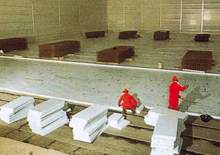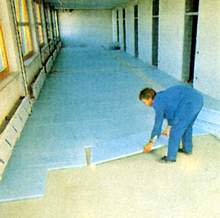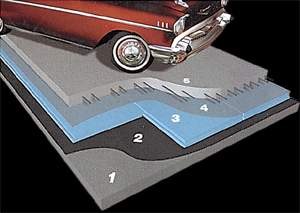|

WHERE ARE THEY USED?
For the floors with high-pressure resistance carrying
heavy weights (cold storage houses, car parking spaces,
floorings of industrial facilities etc.) and for
applications for foundations.

HOW ARE THEY APPLIED?
- After the
application of grocement for the floors built on the
base of industrial facilities, water insulation is
applied on the grocement.
- Floormate*
500 boards are placed on the water insulation system and
polyethylene folio separating layer is laid on top and
rigger floor cement is poured. For the car parking space
and cool house applications after water insulation
system is established (if necessary), Floormate 500
boards are laid on the floor concrete at appropriate
thickness offset tingly. As the separating layer
polyethylene folio is placed and rigger floor cement of
thickness appropriate to the load is applied.

1)
Floor cement
2) Floormate* 200 thermal
insulation board
3) Separation layer,
poly-ethylene folio
4) Mortar
5) Floor covering or alum
layer |
ADVANTAGES
- Floormate*
500 possesses high resistance qualities against pressure
loads and stretching over time. For that reason, it
doesn't cause damage to the materials used for lining.
- Since the
pressure resistance is high it reduces cost for linings
of the type similar to mosaics.
- The water
repent ionic quality of the product enables protection
of the specifications relating to thermal resistance for
possible incidents and prevention of occurrence of
damage likely to happen over time especially for
applications of structural insulation, heating and cold
storage houses.
- For the load
carrying floors the boards of Floormate 500 do not
require additional layers for the even distribution of
the loads, reduces thickness requirements for the rigger
floor concrete.
TECHNICAL SPECIFICATIONS FOR
THE INSULATION OF THE FLOORMATE 500 FLOORING MATERIALS
CARRYING WEIGHTS (INDUSTRIAL, USES, ROOFS OF CAR PARKING
SPACES, COOLHOUSES AND FOUNDATIONS)
MATERIALS FOR THERMAL RESISTANCE (TS 11989
compatible TSE standards). The cap less porous
polystyrene - extruded foam XPS boards used for the
flooring carrying weights must definitely have armored (binded)
surfaces (TSE 825 standards, article number 10.2.1.2.2.
of attachment number 5 of the official gazette numbered
and dated 23725 and June 14, 1999).
RATE
OF THERMAL CONDUCTIVITY (LAMDA). It must not be
larger than 0.027 W/m.K after aging at 10 C for 90 days.
DENSITY. Must not be at lower than 40 kg/m3 density.
PRESSURE RESISTANCE. Must not be lower than 500 kPa
(TSE 11989, class C5).
STRECH
RESISTANCE. It must not be lower than 180 kPa. (This
value can be defined as the load at its maximum, which
the material can carry for 50 years on a continuous
basis under a deformation of up to 2 %. Also, as the
load for statically calculations 180 kPa should be taken
as basis instead of 500 kPa).
WATER
ABSORBTION. The water absorption rate for prolonged
periods using full dipping method must not exceed 0.2 %
in volume.
WATER
ABSORBTION WITH DIFFUSION OVER LONG PERIODS. The
rate of water absorption with diffusion over long
periods must not exceed 1 % in volume.
FROST
THAW. The rate of water absorption using freeze thaw
method must not exceed 0.2 % in volume. Also, the
reduction in pressure resistance as the result of freeze
thaw test must not exceed 2 % (the rate of 10 % as the
standard is the upper limit).
WATER
VAPOUR DIFFUSION RESISTANCE. It must be in between
100 and 200.
SIZE
DETERMINATION
a) Change of dimensions in the length and the width must
be zero at 60 C and 90 % relative humidity.
b) Change in dimensions must not exceed 2 % under 20-kPa
stresses and at a temperature of 80 C.
c) Must not exceed 2 % under 40-kPa stresses and at a
temperature of 70 C.
RESISTANCE TO FIRE. Must pass the B2 test first,
then must be proven that it has passed B1 class by
applying furnace tests and that it has not been
dripping. Besides the documents obtained from TSE there
must also be certificates granted by the test institutes
in Germany.
CAPILARITY. Must be zero.
SPECIFICATIONS OF THE SURFACE. Must be armored
(binding).
LENGTH, WIDTH, DEVIATION FROM THE SET SQUARE, SURFACE
PLAIN, THICKNESS. Must be in conformity of the
tolerances under the TS 11989 standards.
SIDE
PROFILES. Tongued side profiles would prevent the
work of heat bridges.
* Trademark of Dow
Chemical Company.
|




